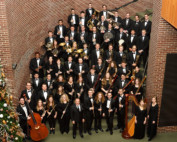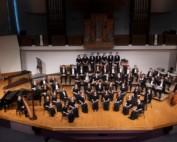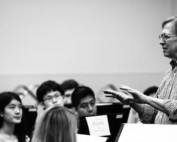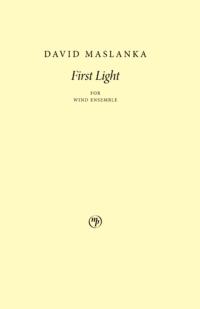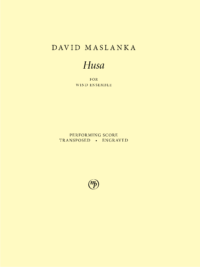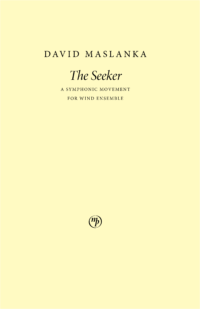Project Description
Wind Ensemble
2000
40 min.
Listen Now
Illinois State University Wind Symphony, Stephen Steele, cond.
On the album Symphony No. 5 (2002)
Instrumentation
Picc Fl-2 Ob-3 EbCl BbCl-3 BCl-2 CACl Bsn-2(2»Cbsn) ASx-2(1»SSx) TSx BSx | Hn-4 CTpt-3(1»BbPicc) Tbn-2 BTbn Euph-2 Tuba DB | Pno Timp Perc-5
- Piccolo
- Flute (2)
- Oboe (3)
- Clarinet in E♭
- Clarinet in B♭ (3)
- Bass Clarinet in B♭ (2)
- Contrabass Clarinet in E♭
- Bassoon (2) (2 dbl Contrabassoon)
- Alto Saxophone (2) (1 dbl Soprano Saxophone)
- Tenor Saxophone
- Baritone Saxophone
- Horn in F (4)
- Trumpet in C (3) (1 dbl Piccolo Trumpet)
- Trombone (2)
- Bass Trombone
- Euphonium (2)
- Tuba (2)
- Double Bass
- Piano
- Timpani
- Required Percussion (5 players)
- Vibraphone
- Xylophone (2)
- Marimba
- Suspended Cymbal (3 sm., 4 lg.)
- Orchestra Bells (3)
- Field Drum (3)
- Tambourine (lg.)
- Marimba
- Tuned Gongs (8) (2 E, F, G, G#, A, B, C)
- Gong (4 med.)
- Tenor Drum (3)
- Crash Cymbal (2)
- Bass Drum (3) (1 sm. with pedal)
- Anvil (2 sm., 2 lg.)
- Snare Drum (1 sm., 1 med.)
- Chimes
- Tom-toms (2)
- Tam-tam (2)
- Bongos
- Temple Blocks (2)
- Triangle (2 med. 1 lg.)
- Brake Drum
- Bell Plate
- Crotales
- Hanging Metal Pieces (3) (e.g. iron dumbbells or scrap iron)
Movements
- Moderate
- Moderate
- Slow
- Very Fast
Commissioned by
Symphony No. 5 was commissioned by Stephen K. Steele of Illinois State University. The composition was supported by the following institutions and individuals, to whom it is gratefully dedicated.
- Arkansas State University, Tom O’Neal
- College Band Directors National Association
- Central Washington University, Larry Gookin
- Concordia University, Richard R. Fischer
- Georgia State University, Thomas Martin Wubbenhorst
- Illinois State University College of Fine Arts, Roosevelt Newson
- Illinois State University Department of Music, James Major
- Illinois State University, Stephen K. Steele
- Indiana University, Ray E. Cramer
- Ithaca College School of Music, Stephen Peterson
- Michigan State University, John L. Whitwell
- Northern Arizona University, Patricia Hoy
- St. Olaf Band/Miles Johnson Endowment – St. Olaf College, Timothy Mahr
- Stephen F. Austin State University, Fred J. Allen
- Tennessee Tech University, Joseph W. Hermann
- Texas Tech University, John Cody Birdwell
- Texas Wind Symphony, Ray C. Lichtenwalter
- University of Arizona, Gregg I. Hanson
- University of Arkansas, W. Dale Warren
- University of Colorado, Allan McMurray
- University of Georgia, H. Dwight Satterwhite
- University of Illinois, James F. Keene
- University of Kentucky, Richard Clary
- University of Massachusetts Amherst, Malcolm W. Rowell, Jr.
- University of Miami, Gary Green
- University of Missouri-Columbia, Dale J. Lonis
- University of Montana, Steve Bolstad
- University of Nevada Las Vegas, Thomas Leslie
- University of Oklahoma and alumni, William K. Wakefield
- University of South Carolina, James K. Copenhaver
- University of Southern Mississippi, Thomas V. Fraschillo
- University of Texas, Jerry Junkin
- University of Washington, Tim Salzman
Program Note
The 371 Four-Part Chorales by J.S. Bach have come a focal point for meh study and meditation. These Chorales are the models for counterpoint and harmonic movement used by every beginning music theory student. I had my first encounter with them as a freshman at the Oberlin Conservatory in 1961. Ten years ago I returned to singing and playing them as a daily warm-up for my composing time. Since then the Chorales have become a deep well for me, a huge access to dream space. The feeling is one of opening an unmarked door in a nondescript building, and being suddenly thrust into a different world. The Chorales are this mysterious door to other worlds.
In the many years of my composing, I have been drawn as if magnetically to the themes of loss, grief, and transformation, They have been person issues for me, but all along the way have toughed something deeper as well. Folk music is powerful – and I include the Chorales in the Folk tradition – because the same melodic impulse, touched and shaped by generations of minds, hearts, and souls, moves beyond individual experience. Such melodies bear the weight of all human experience, and open a path for the deepest of all connections.
In 1975 I had the idea to compose a Mass using the texts of the Latin Ordinary. It took nearly 20 years of personal and musical development to feel ready to do this, and the Mass was composed in 1994-95. I am not a Catholic, nor even a practicing Christian, yet the Mass text was like a beacon, forecasting a long working-out process that would allow me to be clear enough to actually write the piece. From my current perspective it appears that much of my work prior to 1994 was a prelude to the Mass, and the pieces since, largely a reflection on the Mass.
Symphony No. 5 is no exception. It has been composed around three well-known Chorale melodies: “Durch Adams Fall” (Through Adam’s Fall) in the first movement, “O Lamm Gottes, Unshuldig” (O Lamb of God, Without Blame) in the second, and “Christ Lag in Todesbanden” (Christ Lay in the Bonds of Death) in the third and fourth. The third is a meditation on the theme of “Christ entombed”, and the fourth is a full-blown fantasia on the “Christ Lag” melody. Much of the music of this Symphony is urgent and insistent. Have used the words “aggravated”, “angry”, and “overwhelming” by way of description. But for all its blunt and assertive force, the Symphony is not tragic. It is filled with a bright and hopeful energy. The music does not try to illustrate the story of the Mass, but rather continually speaks to the theme of transformation – the transformation of tears into power, and the victory of life over death.
Program Note by David Maslanka
Further Reading
Maslanka Weekly: Best of the Web – No. 121, Michigan State University Bands
Maslanka Weekly highlights excellent performances of David Maslanka’s music from around the web. This week, we feature various ensembles from Michigan State University playing recent performances of David's music: Symphony No. 5, Hymn for World Peace, and Symphony No. 8.
Interview with Tiffany Woods (2003)
In May 2003, Tiffany Woods emailed David a series of questions in the course of writing a paper. She was a student at the University of North Carolina Greensboro and taking a Band Literature course [...]
From the Maslanka Archive – No. 31, Julian Velasco’s Interview of David – Part 1
From the Maslanka Archive features media and stories of David's life and work. This week, we are excited to feature Part 1 of Julian Velasco's interview of David from his home in Missoula, MT in 2016.
Maslanka Weekly: Best of the Web – No. 91, David’s Symphonies Around the World
Maslanka Weekly highlights excellent performances of David Maslanka’s music from around the web. This week, we travel from the corn fields of Iowa - to the exciting streets of Paris - to the historic sights of northern Portugal to feature three new performances of favorite symphonies: Symphony No. 9, Symphony No. 10, and Symphony No. 5.
Maslanka Weekly: Best of the Web – No. 37, New Performances of Favorite Works
Maslanka Weekly highlights excellent performances of David Maslanka’s music from around the web. This week, we feature three new performances of favorite works: Symphony No. 8, Symphony No. 5, and Hell's Gate.
Maslanka Weekly: Best of the Web – No. 19, Durch Adams Fall
Maslanka Weekly highlights excellent performances of David Maslanka’s music from around the web. This week, we feature thrilling performances of Symphony No. 5 and Recitation Book, Mvt. 5, "Fanfare/Variations on Durch Adams Fall."
David Maslanka: Works for Younger Wind Ensembles
Here are more than twenty works for wind ensemble, arranged in approximate ascending order of difficulty, with commentary by David Maslanka
Recording the Wind Ensemble Music of David Maslanka
Mark Morette of Mark Custom Recording shares his extensive experience in recording wind ensembles.
Maslanka Symphony No. 5: Conducting Via Lucid Analysis Technique
Dr. Christopher Werner's doctoral dissertation uses David's Symphony No. 5 as a means of exploring a new score study and conducting performance method, the Lucid Analysis Technique, which is of his own creation. As explained [...]

